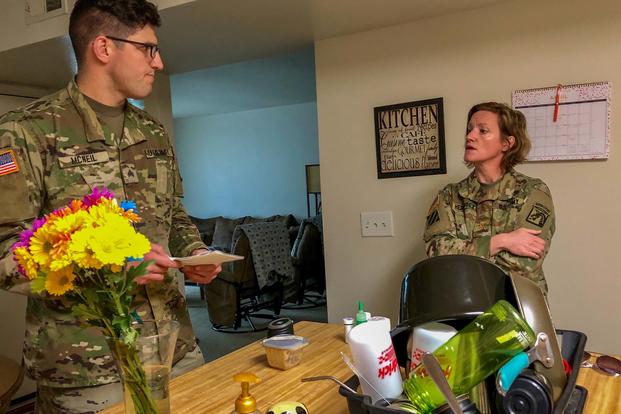Satisfaction with privatized military housing has declined since last year for both the Army and Navy, according to surveys released by the services Thursday.
But while soldiers and families living in base housing can view the survey results and see where their installations fall on the spectrum, the results of the Navy survey don’t contain specifics for each base and provide only a general look at the overall state of Navy housing.
After a scandal earlier this year as reports came to light of vermin, mold and lead contamination in U.S. military housing managed by private companies, the services launched a series of inspections and fixes, including resident surveys, to determine the extent of the issues and how to address them.
According to the Army survey conducted by CEL & Associates, the service saw overall satisfaction decline by nearly six points on a 100-point scale, from 80.5 to 74.6, which translates into a drop in ratings from “very good” to “average.” The score’s components — property satisfaction and satisfaction with service — both declined, with property satisfaction dropping 6.4 points from “good” to “average” and service satisfaction dropping six points from “very good” to “average.”
The Navy saw the average overall satisfaction rates drop by nearly 12 points, with properties ranging from “poor” to “good.” No Navy housing projects earned a score of “very good” or “outstanding.” Property satisfaction and service satisfaction for 10 different projects also dropped by seven to nearly 16 points, and no Navy housing saw any increases in satisfaction rates.
For the Army, installations with the highest marks, receiving scores considered “outstanding,” were Fort Greely, Alaska; Fort Huachuca, Arizona; and Picatinny Arsenal, New Jersey. Housing at those installations is managed by Lendlease, Michaels and Balfour Beatty Communities, respectively.
Fort Bragg was at the bottom of the list with an overall rating of 58.9, or “very poor.” The North Carolina base housing is managed by Corvias. Fort Meade, Maryland, also managed by Corvias, and Fort Carson, Colorado, managed by Balfour Beatty, were the only two installations to receive “poor” ratings.
A spokeswoman for Corvias told Military.com that the survey was taken before the company made improvements to its property management operations. She added, however, that Corvias is “using the survey — as well as direct resident feedback — to continue to make improvements.”
“We want to hear from residents, and we are listening and responding, providing better service and working with our Army partner to meet both the short- and long-term military housing infrastructure needs,” said Kelly Douglas, Corvias media and marketing strategist.
The remainder of the Army’s bases were in between, with ratings from very good to below average.
“Feedback from residents is extremely valuable for measuring and improving the quality of housing on Army installations,” said Alex Beehler, assistant secretary of the Army for Installations, Energy and Environment, in a news release. “The results of this year’s survey will be used to continue identifying the concerns of our residents, and will guide Army staff and the private housing companies on ways we can improve the quality of life for our soldiers and their families.”
But while the Army’s survey results provide a full accounting for base housing on every installation, allowing residents to determine how their homes and management companies measure up, the Navy’s survey results did not contain the names of the installations or contractors.
Navy officials said in a release that the project names were redacted “because the Navy’s business agreements with our public private venture housing partners limit the type of information we can release publicly.”
Thus, Navy residents have no way to determine which companies are performing better or worse than others across the service.
Navy officials said the survey was conducted because, under agreements with the housing companies, those that score less than 75 points in overall satisfaction must submit an action plan to address issues found by the survey.
“We continue to improve our existing processes and make changes that are designed to enhance our residents’ housing experience and quality of life,” said Greg Wright, housing director for Commander, Navy Installations Command, in a statement. “The survey results confirmed that many of our immediate actions were focused on the correct areas, and the results provided a more in-depth look at other areas of concern.”
The surveys were sent to personnel and families living in military housing. Questions were asked on the quality of property and service, such as responsiveness, quality of workmanship and support.
The Army sent surveys to 79,388 homes at 43 installations across 381 neighborhoods and received 23,431 back, a response rate of nearly 30%.
The Navy sent 35,215 surveys to 10 projects across 42 installations. More than 8,400 were returned, for a response rate of 24%.
An analysis of resident comments to the survey found that for Navy families, unresolved issues with their housing were the top complaint, with roughly 30% saying they had ongoing problems.
“Residents should report deficiencies to the property managers immediately,” Wright said in a release. “If the issue is not resolved to their satisfaction, residents should notify their Navy Housing Service Center or chain of command, who will advocate on their behalf.”
Soldiers reported their top concerns as visitor parking, pest control, landscaping and the conditions of their communities.
The Navy report included recommendations for the Navy to improve its results, including resolving all health and safety issues, establishing an action plan and training employees on it, and educating residents on the housing process, from basic allowance for housing and payments to management companies to reporting and resolving issues.
“We need to do a better job to ensure that service members and their families are aware of the resources available to them,” Wright said. “The government employees at the installation Navy Housing Service Centers are a wealth of knowledge and experience and are trained to help residents resolve housing issues as quickly as possible.”
Source: military





